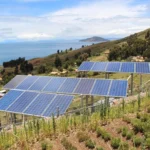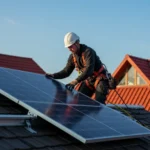Solar String Sizing Check: Did Your Installer Get It Right?
Solar String Sizing Check: Did Your Installer Get It Right?
A Solar PV Rooftop system will give its optimum performance only when the string sizing has been done correctly. In this blog, we will be talking on correct methods of string sizing.
Now let us first understand what a String is. When we connect Solar PV panels, used in solar power plant for generating solar energy for home/industrial/commercial roof top or ground mounted, in series, then it is called a String. String sizing means, what should be the minimum and maximum number of Solar PV panels to be connected in a string, so that system operates at its highest efficiency.
Output parameters of Solar PV panel , used in solar power plant for generating solar energy for home/industrial/commercial roof top or ground mounted ,should match the input parameters of the Inverter, so that the system works at its highest efficiency. If the parameters do not match, or falls out of the range, the system will shut down or will work with very less efficiency. Hence, String sizing must be done correctly.
Parameters of Solar PV vary with change in temperature. With increase in temperature the voltage of Solar PV panel decreases and this need to be consider while sizing the string. One needs to check the Technical Data Sheet of Solar PV panel (as given by manufacturer) for calculating the effect of temperature on a particular Solar PV Panel and then match that with the Inverter input parameters. Until and unless this is done, we can’t say that the system is designed perfectly and will perform best.
For example, if the strings are not sized considering the temperature factor and inverter input parameters, then there may be situations when the Solar PV Panel parameters will not match the inverter input parameters and the system will shut down or will under perform.
Our string sizing goals should be ::That we make sure never to supply the inverter excess voltage which may kill it—Max string length. Voc adjusted for temp will decide Max string length.
And also to ensure that we always supply enough voltage to inverter to turn it on—minimum string length. Vmp adjusted for temp will decide Min string length.
So you need to ask your installer, did he consider these parameters while string sizing ? Has he actually done string sizing or made a string by just counting the even numbers of PV panels in series?
Keep visiting our website for more such blogs.
Suggested Articles

India Solar Energy Policies: Key Updates and Government Initiatives
India is one of the leading countries in terms of solar energy development, having become the fastest-growing market for solar power globally.

India’s Renewable Energy Revolution: The Role of Agrivoltaics
Agrivoltaics, the integration of solar panels with agricultural land, is emerging as a key driver in India’s renewable energy revolution. This blog explains how agrivoltaics supports sustainable farming, increases land efficiency, and contributes to clean energy production, helping India meet its solar energy targets while boosting rural economies.

Save on Electricity in Haryana Using Net Metering: A Complete Guide
Learn how to save on electricity in Haryana with net metering. Step-by-step guide on benefits, installation, and cost savings for your home or business

Rajasthan Rooftop Solar Subsidy: What Homeowners Need to Know
Rajasthan homeowners can save big with the 2025 rooftop solar subsidy. Learn about the updated rates, eligibility criteria, and benefits to make your switch to solar more affordable.

Solar Rooftop Subsidy: Why It’s Time for a Change of Mindset
While solar rooftop subsidies help reduce upfront costs, true adoption requires a mindset shift. This guide discusses why businesses and homeowners should focus on long-term benefits, sustainability, and strategic planning beyond relying solely on incentives.

UP Discoms Propose 9.21% Electricity Tariff Hike for 2015-16
Uttar Pradesh Discoms propose a 9.21% increase in electricity tariffs for 2015-16, impacting residential, commercial, and industrial consumers across the state.

Rooftop Solar for Factories: Maximum kW You Can Install
Industrial rooftop solar guide: Understand KW capacity limits, installation guidelines, and best practices for factories and manufacturing units

India and Japan Strengthen Renewable Energy Cooperation
India and Japan have initiated a partnership under the Asia Energy Transition Initiative (AETI) to support India’s clean energy transition. India has set an ambitious target of achieving net-zero by 2070, while Japan aims to achieve the same by 2050.